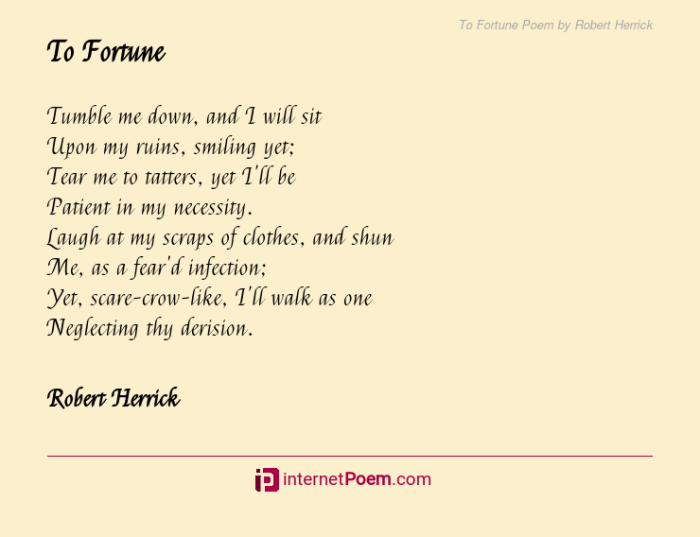The Vine by Robert Herrick, a masterpiece of English literature, invites readers to embark on a journey through the intertwined themes of love, nature, and mortality. This enchanting poem, with its rich imagery and evocative language, offers a captivating exploration of the human experience.
Herrick’s skillful use of poetic devices, such as metaphors and personification, brings the vine to life, transforming it into a symbol of both the joys and sorrows of existence. Through its exploration of the changing seasons and the fleeting nature of life, The Vine resonates with readers across time, offering timeless insights into the human condition.
Overview of “The Vine” by Robert Herrick

Robert Herrick’s “The Vine” is a poem that celebrates the beauty and transformative power of nature, particularly as it manifests in the vine and its fruit, the grape. It was written during the 17th century, a time of great social and political upheaval in England, and reflects Herrick’s longing for a simpler, more idyllic existence.
The poem is structured as a series of four stanzas, each of which explores a different aspect of the vine’s significance.
The Vine by Robert Herrick is a classic poem that explores the themes of love, beauty, and the passage of time. The poem’s lush imagery and lyrical language have made it a favorite of readers for centuries. For a deeper dive into the poem’s strengths, weaknesses, opportunities, and threats, check out the Swot Analysis For Toms Shoes . This analysis provides valuable insights into the poem’s literary merits and its enduring legacy.
Context of Creation
Herrick wrote “The Vine” during a period of personal and national turmoil. The English Civil War was raging, and Herrick, a Royalist, had been forced to flee his home and live in exile. In this context, the poem can be seen as a nostalgic longing for a lost world, a world in which the beauty and simplicity of nature could provide solace and escape from the chaos of human affairs.
Main Theme and Structure
The main theme of “The Vine” is the transformative power of nature. Herrick uses the vine as a symbol of this power, showing how it can bring life, beauty, and joy to even the most barren places. The poem is structured as a series of four stanzas, each of which explores a different aspect of the vine’s significance.
Place within Herrick’s Body of Work
“The Vine” is one of Herrick’s most famous and beloved poems. It is a classic example of his lyrical style, which is characterized by its simplicity, clarity, and musicality. The poem has been praised by critics for its beauty and its ability to capture the essence of the natural world.
Analysis of Poetic Devices

Robert Herrick’s “The Vine” employs a rich tapestry of poetic devices to convey its message. These devices not only enhance the poem’s aesthetic appeal but also contribute significantly to its meaning and impact.
Metaphors and Similes
Metaphors and similes abound in “The Vine.” Herrick compares the vine to a “serpent,” a “witch,” and a “leech.” These comparisons create vivid images that help the reader visualize the vine’s destructive nature. The simile “like a witch” is particularly effective in suggesting the vine’s ability to cast a spell over its victims.
Personification and Imagery
Herrick also uses personification and imagery to bring the vine to life. He describes the vine as “creeping,” “choking,” and “sucking.” These verbs give the vine a sense of agency and purpose. The imagery of the vine “sucking” the life out of the tree creates a powerful and disturbing picture of the vine’s destructive power.
Rhyme, Rhythm, and Meter
The poem’s rhyme, rhythm, and meter contribute to its musicality and memorability. The regular iambic tetrameter creates a steady, hypnotic rhythm that draws the reader into the poem’s world. The use of end rhyme (e.g., “tree” and “me”) provides a sense of closure and satisfaction at the end of each line.
Interpretation of Symbolism: The Vine By Robert Herrick

The poem “The Vine” by Robert Herrick is rich in symbolism, with the vine and its products representing various aspects of human experience.
The vine itself is a symbol of both pleasure and excess. Its leaves and tendrils provide shade and shelter, while its grapes can be made into wine, a drink that brings joy and intoxication. However, the vine can also be destructive, as its roots can spread and choke other plants, and its thorns can cause pain.
Wine and Drinking
Wine is a recurring symbol in the poem, representing both pleasure and excess. The speaker celebrates the joys of drinking wine, but he also warns of the dangers of overindulgence. In the first stanza, he invites his readers to “quaff” wine, but in the second stanza, he warns that “the drunkard’s eyes are red.”
Wine can be a source of pleasure and conviviality, but it can also lead to drunkenness and debauchery.
Garden and Nature Imagery, The vine by robert herrick
The poem is set in a garden, a place of beauty and tranquility. The speaker finds solace in the garden, and he compares the vine to a “fair lady” who “sits in state.” The garden is a symbol of order and harmony, in contrast to the chaos and excess of the vine.
Nature imagery is used throughout the poem to create a sense of beauty and abundance.
Exploration of Themes

The poem explores the intertwined themes of love, nature, and mortality. These themes are interwoven throughout the poem, reflecting the speaker’s changing perspective on life and its fleeting nature.
Theme: Love
- The poem celebrates the beauty and transformative power of love.
- The speaker’s love for his mistress is presented as a source of joy, inspiration, and renewal.
- However, the poem also acknowledges the fragility and impermanence of love, as the speaker recognizes that time and circumstances can erode even the strongest bonds.
Theme: Nature
- Nature is depicted as a source of beauty, wonder, and renewal.
- The speaker draws parallels between the natural world and the human experience, suggesting that both are subject to the cycles of life and death.
- The poem also explores the interconnectedness of all living things, emphasizing the importance of harmony and balance in the natural world.
Theme: Mortality
- The poem is infused with a sense of mortality and the inevitability of death.
- The speaker reflects on the brevity of life and the transience of human existence.
- However, the poem also offers a message of hope and resilience, suggesting that even in the face of death, the beauty and joy of life can be celebrated.
Comparative Analysis
Robert Herrick’s “The Vine” shares similar themes with several of his other poems, particularly those exploring the fleeting nature of beauty, the power of love, and the joys of wine. In “Corinna’s Going a-Maying,” Herrick celebrates the arrival of spring and the beauty of a young woman, urging her to seize the day before her youth fades.
Similarly, in “The Vine,” Herrick extols the virtues of the grapevine, a symbol of life, love, and the passage of time.
Influence and Connections
Herrick’s “The Vine” draws inspiration from classical and Renaissance literature, particularly the works of Horace and Anacreon. Like these poets, Herrick uses the vine as a metaphor for the cycle of life and the pleasures of love. The poem’s emphasis on the fleeting nature of beauty and the importance of enjoying life while one can is also reminiscent of the carpe diem theme common in Renaissance poetry.
Answers to Common Questions
What is the central theme of The Vine?
The central theme of The Vine is the interconnectedness of love, nature, and mortality, and the fleeting nature of life.
How does Herrick use poetic devices in The Vine?
Herrick employs metaphors, similes, personification, and imagery to create a vivid and evocative portrayal of the vine and its symbolic meanings.
What is the significance of the garden setting in The Vine?
The garden setting represents the beauty and abundance of nature, as well as the cycle of life and death.
